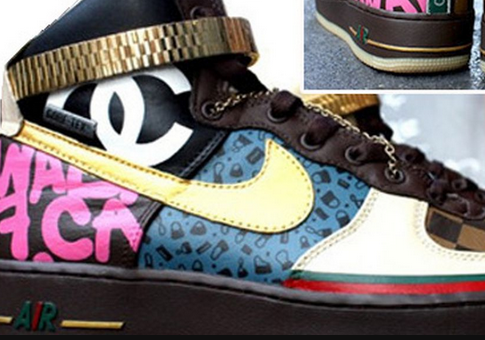Your cart is empty now.

Counterfeit products - Fake Nike and Amazon, and how they agreed to disagree
- 24 April, 2024
- Nyall Engfield
Counterfeit products - Fake Nike and Amazon, and how they agreed to disagree
Counterfeiting is a pervasive issue that has affected countless industries globally, with the fashion and sports apparel sectors being particularly vulnerable. Nike, one of the world's most recognizable brands, has been battling counterfeit products for decades. The advent of online shopping platforms like Amazon has both compounded and offered new strategies to tackle these challenges. Here’s an in-depth look at how counterfeiting has influenced Nike’s sales over the years and the complex relationship between Nike and Amazon, particularly how the presence of counterfeits on Amazon's platform has played a role in their business dealings.
Nike’s Battle Against Counterfeits
Nike, as a leading innovator in athletic apparel, footwear, and accessories, has consistently maintained a strong brand image that symbolizes quality and authenticity. However, this prominence also makes Nike a prime target for counterfeiters. Fake Nike products not only dilute the brand’s market but also damage its reputation, as consumers unknowingly purchasing inferior counterfeit goods may attribute poor quality and performance to Nike.
Counterfeit Nike products range from near-perfect replicas to shoddy imitations, and they are distributed globally. Before the rise of online shopping, these goods were typically sold through informal markets and street vendors. However, the emergence of e-commerce has significantly broadened the scope and reach of counterfeit products, making it easier for counterfeiters to find unsuspecting customers and harder for brands to track and manage these infringements.
The Role of Amazon in Nike’s Retail Strategy
Amazon, as the largest online retailer in the world, has become a critical player in the retail strategies of countless brands, including Nike. For many years, Nike resisted selling directly on Amazon, preferring to control its distribution channels more tightly and enhance its brand experience through its stores and website. However, the landscape of retail has been shifting dramatically, influenced heavily by the convenience and dominance of Amazon in the market.
A significant part of Nike's eventual decision to partner directly with Amazon in 2017 was the rampant sale of counterfeit goods on the platform, which some sources indicate that Amazon encouraged to bring Nike to heel.
By joining forces with Amazon, Nike aimed to exert more control over the branding and distribution of its products. The idea was to limit the availability of counterfeit items by providing customers with a direct, reliable source of genuine Nike products on Amazon.
How Amazon Encouraged Nike by Addressing Counterfeits
Amazon has faced criticism over the years for not doing enough to combat the sale of counterfeit goods on its platform. This issue is not unique to Nike; many brands have struggled with the presence of fakes being sold by third-party sellers on Amazon. In response, Amazon has implemented several measures to reassure brands and protect consumers, such as the Brand Registry, Project Zero, and the Transparency program, which are designed to help identify and remove counterfeit listings and provide brands with tools to protect their intellectual property.
These initiatives were part of what encouraged Nike to finally sell directly through Amazon. Amazon's willingness to work closely with Nike to clean up listings and enforce Nike’s intellectual property rights helped persuade Nike that partnering with Amazon could be beneficial in controlling brand presentation and combating counterfeit sales.
Impact on Sales and Brand Image
The direct relationship between Nike and Amazon had mixed results. On one hand, Nike was able to present a unified brand front, reduce the prevalence of counterfeit products, and reach a wider audience. On the other hand, Nike still struggled with the challenge of third-party sellers who might undercut prices or distribute counterfeit goods, albeit to a lesser extent.
In 2019, Nike announced that it would end its direct sales partnership with Amazon, opting instead to focus on direct relationships with customers through its own channels. This decision was driven by Nike’s strategy to enhance brand experience through personalization and direct engagement, which was difficult to achieve within the Amazon ecosystem.
The Continuing Fight Against Counterfeits
Despite the end of this partnership, the fight against counterfeits continues. Nike remains vigilant in its legal and brand protection efforts, constantly monitoring various retail channels and taking action against counterfeit products. Meanwhile, Amazon continues to develop and implement advanced technologies and policies to detect and eliminate fakes, though the challenge persists given the platform's scale, the sophistication of counterfeiters and Amazon's low motivation to remove them.
Conclusion
The dynamics between Nike and Amazon highlight the complex interplay between brand protection, market reach, and the challenges posed by counterfeit products in the digital age. While online platforms like Amazon offer brands the opportunity to expand their reach, they also create significant challenges in brand control and protection against counterfeiting. Nike’s experience with Amazon underscores the broader industry struggle with these issues and reflects the ongoing evolution of retail strategies in response to changing technologies and consumer behaviors. As both companies continue to adapt and innovate, their experiences offer valuable lessons in balancing brand integrity and market presence in an increasingly digital world.
Damages for Counterfeit Products under the Lanham Act
The Lanham Act provides for statutory damages in cases involving the use of counterfeit marks. A plaintiff may elect to recover statutory damages instead of actual damages and profits. The amount of statutory damages can range from not less than $1,000 to more than $200,000 per counterfeit mark per type of goods or services sold, offered for sale, or distributed, as the court considers just. If the court finds that the use of the counterfeit mark was willful, the maximum limit for statutory damages increases to $2,000,000 per counterfeit mark per type of goods or services sold, offered for sale, or distributed.
A counterfeit mark, as defined under the Lanham Act, is a spurious mark which is identical with, or substantially indistinguishable from, a registered mark. To be substantially indistinguishable, two marks must be nearly identical with only minor differences which would not be apparent to an unwary observer Hudson Furniture, Inc. v. Mizrahi, 2024 U.S. Dist. LEXIS 21939.
The Lanham Act also allows for statutory damages for contributory counterfeiting. This applies if the defendant provided goods or services necessary to the counterfeiting violation and intended that the recipient of its goods or services would commit counterfeiting. The potential recovery for contributory counterfeiting includes treble damages or profits and attorneys' fees.
The amount of statutory damages awarded may be influenced by the number of goods at issue. However, only one award may be obtained for each type of good or service bearing a counterfeit mark. For example, sales of 400 hats or 4, 000 hats bearing a counterfeit mark would still receive a single statutory award.
The Lanham Act does not provide any guidance as to factors courts should consider when setting statutory damages, and courts have wide discretion to determine the appropriate amount of statutory damages Anti-counterfeiting Strategies and Counterfeiting ClaimsGS Holistic, LLC v. Sphinx, Inc., 2023 U.S. Dist. LEXIS 212969GS Holistic LLC v. Wellness by VCT, LLC, 2023 U.S. Dist. LEXIS 212976. In general, the statutory award should be small enough to correspond rationally to the actual damages incurred but substantial enough to deter the defendant from engaging in similar infringing conduct in the future.
In addition to statutory damages, the court may award prejudgment interest on such amount at an annual interest rate established under section 6621(a)(2) of the Internal Revenue Code of 1986, beginning on the date of the service of the claimant’s pleadings setting forth the claim for such entry of judgment and ending on the date such entry is made, or for such shorter time as the court considers appropriate § 1117. Recovery for violation of rights.



